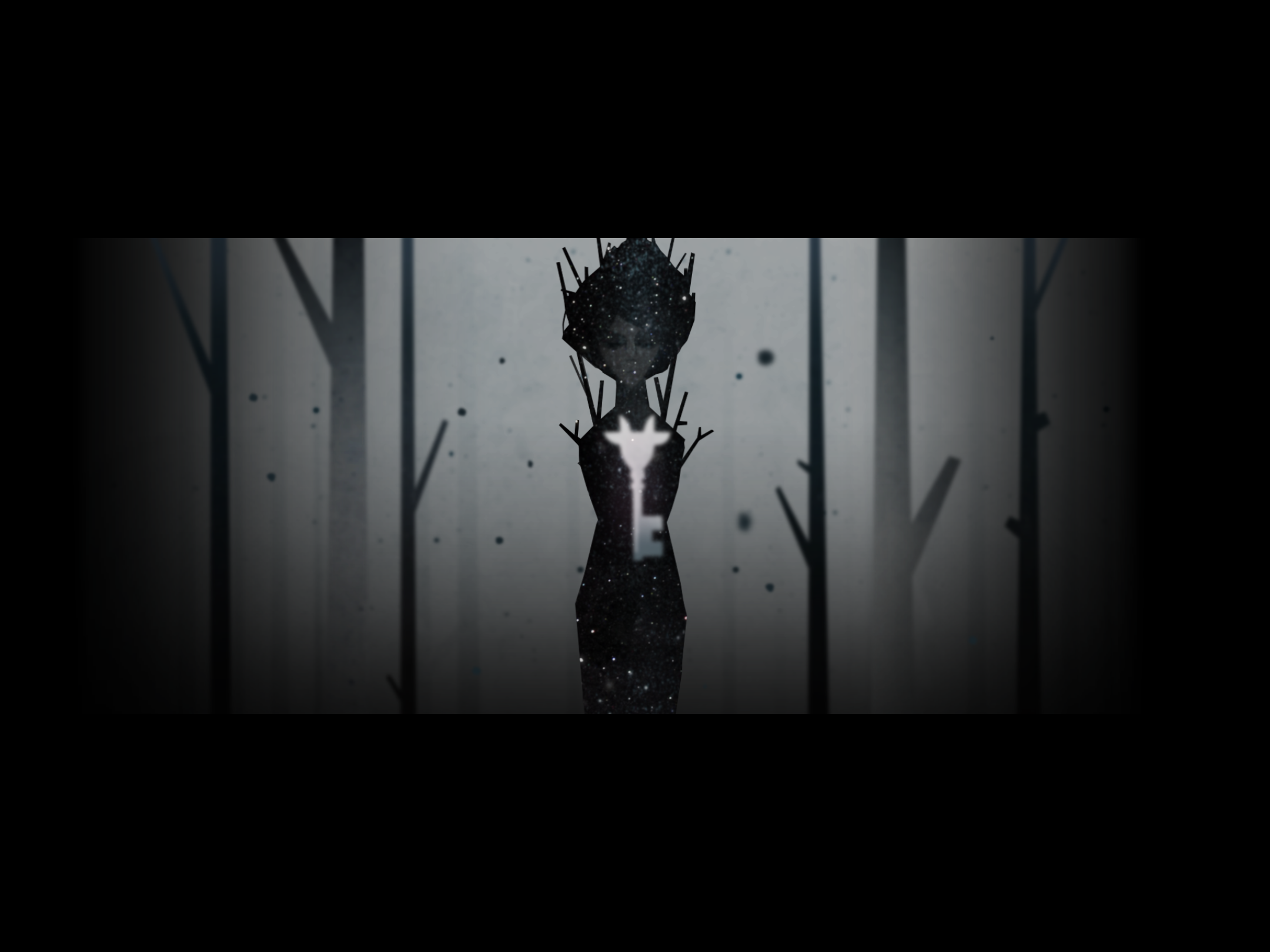Name of game, creator, platform:
I played Year Walk, a game created by developer Simogo. The game was designed for iOS devices and I played it on an iPad.
Target Audience:
Casual gamers (the game is quite short and is on mobile devices), people who like puzzle games, people who are interested in games that have supernatural elements or explore supernatural traditions (Year Walk is loosely based on an ancient Swedish tradition).
Important Formal Elements of the game:
Players: single player. This is important because the game is motivated by an enacting narrative. Player plays as someone who is participating in a tradition that would allow him to see the future.
Objectives: complete all the puzzles.
Rules / Procedures: Player navigates around a limited area, looking for clues to solve the next puzzle. Player have access to most of the locations from the beginning of the game, but might need to solve clues in order enter certain areas or reveal interesting features of an area.
Boundaries: The game has a companion app that at first glance functions as a guide to the tradition that the game is based on, but actually contains a story that could be used to solve an unsolved puzzle in the main game, unveiling the actual ending. The game hints towards this additional part in 2 ways: by introducing the unsolved puzzle very early in the game (it was the first one that most players would encounter), and by introducing the code to the story at the end of the game, when players have completed all puzzles.
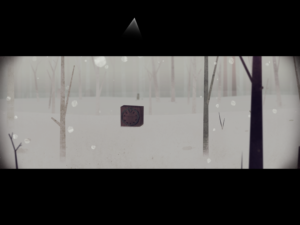
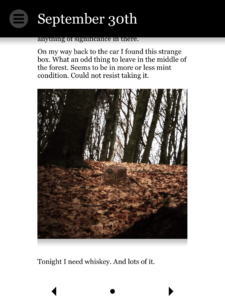
(Left: the unsolvable puzzle in the main game. Right: how it was introduced again in the companion app.)
I thought the introduction of the code at the end of the game was a smart design choice (as opposed to interleaving the code in the main game). The main game requires a high cognitive load (for example, one puzzle requires remembering 4 pairs of patterns in 4 different locations, going to another location to memorize 4 more pairs of patterns, then going to another location and use the common pattern between the 2 sets of pairs to solve a puzzle — see screenshots below). Were the code introduced in the middle of the game, players could have easily forgotten it due to having to focus on the main puzzles, and might not check out the companion app.
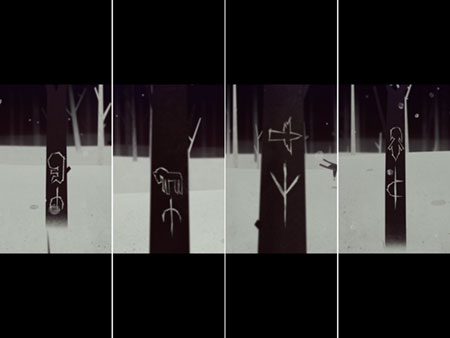
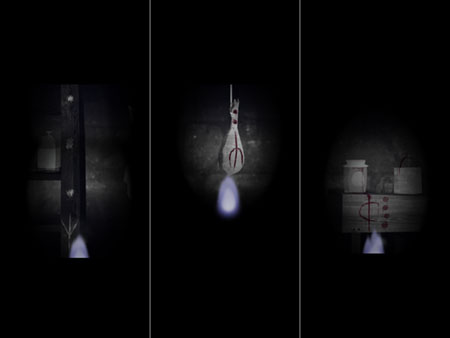
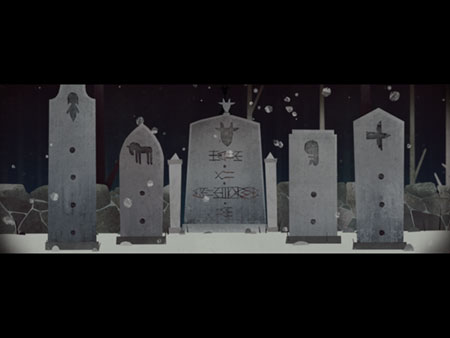
(a complicated series of hints to puzzle. First you track down the trees with carvings of an animal / person with a symbol, then travel to another location to match the symbol with certain numbers of dots, then travel to a graveyard to match the animal / person with the corresponding dots.)
Type of fun game intended, and if it met its goals:
The game intends to bring fun as Challenge, Discovery and Narrative. It delivers fun as Challenge really well, making use of different modalities and of the fact that it is played on a mobile device. For example, in one puzzle, player has to choose the correct path based on which singing voice is in tuned with the background music (different modalities). In another puzzle, the player uses 1 hand to “keep” a baby and the other to navigate. If the player doesn’t use 1 hand to hold on to the baby, it will simply move back to its original position (control specific to mobile device).
As for fun as Discovery and Narrative, I think the game doesn’t deliver on those aspects as much as fun as Challenge. Players would enjoy discovering different aspects of the world (especially players who are not familiar with the tradition, because of the eerie quality that they have). However, without the companion app (which explains what these symbols are and what they mean), the main game itself does not provide enough context or details about these symbols for players to appreciate them — they become merely “setting” for the puzzles.

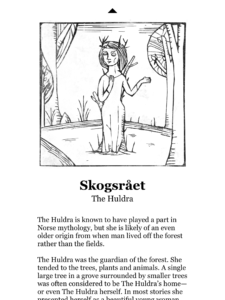
(The Huldra, an interesting aspect of the Swedish tradition inspiring the game, was only introduced as the “setting” for a puzzle in the main game (left). I think more fun as Discovery could have been delivered if more details about the Huldra from the companion app (right) could have been injected in to the main game.)
As for fun as Narrative, again, the companion app delivers more on the narrative compared to the main game. The game has an enacting narrative where you play as a character going on a “year walk”. The “prologue” of the game aims to establish this narrative by describing the year walking tradition, suggesting that your character is participating because he wants to see the future, introducing your love interest who is preparing to marry another person and who warns you from doing the year walk. However, the writing of this narrative was not strong enough to establish the character and the motivation. When players meet the love interest, the writing did not suggest that they are lovers. There was also no specific reason why this particular character has the motivation of “seeing the future,” which prevents the player to identify with him, and reduces the effectiveness of the enacting narrative.
Moments of particular success or epic fails:
Particular success: The game makes quite good use of locks and keys in order to guide the player on which puzzle to work on next, while still maintaining the player’s freedom to roam the world (this also has the additional effect of avoiding ludo-narrative dissonance, because it would be unlikely that the protagonist is unable to access parts of the woods where he lives). For example, from the beginning of the game the player can access a dark hut that contains one of the later puzzles in the game. However, the hut is completely dark at this point. At a future point in the game, the player gets a torch that they can use to light up the hut. This coincides with when the player needs to use information from the hut to solve a puzzle.


(Left: the hut before the appropriate puzzle is solved and player gets a torch. The only light is from the entrance of the hut. Right: once player gets a torch, they can navigate around the hut and climb a ladder, leading to a new area.)
Epic fail: As mentioned above, the narrative of the game is not compelling enough as a drive for the player. This is especially an issue because the game focuses on making these narrative moments very impactful (for example, revealing that the love interest dies at the end of the game), which can create a dissonance for players who have mostly been focused on the game as Challenge fun. The failure is even more noticeable because the story included in the companion app features a more fleshed-out main character with a strong personal motivation for year-walking, as well as more context for the main game’s story (for example, the names of the main character and the love interest, and their relationship, were only revealed in the companion app). The companion app is a small enacting narrative game (where the objective is to solve the “unsolvable” puzzle in the main game), but was able to deliver on Narrative fun much better than the main game.
Things you would change to make the game better:
The strength of Year Walk is as a game that delivers fun as Challenge, which it delivers very well. I would reduce the emphasis on Narrative fun and focuses more on its strength as a puzzle game, or perhaps create an overarching narrative that integrates better with the puzzles, and that integrates more details of the interesting figures from the Swedish tradition that inspired it for more fun as Discovery.


